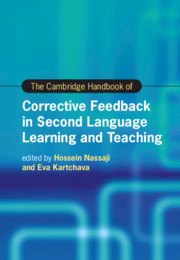Book contents
- The Cambridge Handbook of Corrective Feedback in Second Language Learning and Teaching
- Cambridge Handbooks in Language and Linguistics
- The Cambridge Handbook of Corrective Feedback in Second Language Learning and Teaching
- Copyright page
- Contents
- Figures
- Tables
- Contributors
- Acknowledgments
- Introduction Corrective Feedback in Second Language Teaching and Learning
- Part I Theoretical Perspectives on Corrective Feedback
- Part II Methodological Approaches in the Study of Corrective Feedback
- Part III Different Delivery Modes of Corrective Feedback
- Part IV Feedback Provider, Feedback Intensity, and Feedback Timing
- 13 Peer Feedback in Second Language Oral Interaction
- 14 Focused versus Unfocused Corrective Feedback
- 15 Corrective Feedback Timing and Second Language Grammatical Development: Research, Theory, and Practice
- 16 Explicit and Implicit Oral Corrective Feedback
- Part V Corrective Feedback and Language Skills
- Part VI Contexts of Corrective Feedback and Their Effects
- Part VII Learners’ and Teachers’ Feedback Perspectives, Perceptions, and Preferences
- Part VIII Individual Differences, Tasks, and Other Language- and Learner-Related Factors
- Index
- References
13 - Peer Feedback in Second Language Oral Interaction
from Part IV - Feedback Provider, Feedback Intensity, and Feedback Timing
Published online by Cambridge University Press: 26 February 2021
- The Cambridge Handbook of Corrective Feedback in Second Language Learning and Teaching
- Cambridge Handbooks in Language and Linguistics
- The Cambridge Handbook of Corrective Feedback in Second Language Learning and Teaching
- Copyright page
- Contents
- Figures
- Tables
- Contributors
- Acknowledgments
- Introduction Corrective Feedback in Second Language Teaching and Learning
- Part I Theoretical Perspectives on Corrective Feedback
- Part II Methodological Approaches in the Study of Corrective Feedback
- Part III Different Delivery Modes of Corrective Feedback
- Part IV Feedback Provider, Feedback Intensity, and Feedback Timing
- 13 Peer Feedback in Second Language Oral Interaction
- 14 Focused versus Unfocused Corrective Feedback
- 15 Corrective Feedback Timing and Second Language Grammatical Development: Research, Theory, and Practice
- 16 Explicit and Implicit Oral Corrective Feedback
- Part V Corrective Feedback and Language Skills
- Part VI Contexts of Corrective Feedback and Their Effects
- Part VII Learners’ and Teachers’ Feedback Perspectives, Perceptions, and Preferences
- Part VIII Individual Differences, Tasks, and Other Language- and Learner-Related Factors
- Index
- References
Summary
This chapter presents an overview of the research on peer feedback in L2 oral interaction. The chapter starts with types and characteristics of peer feedback, followed by the discussion of the theoretical underpinnings of peer feedback to explain the benefits of peer interaction in L2 development. The next section presents a review of the studies on peer feedback focusing on the effect of peer feedback on L2 development and factors affecting this type of feedback. The chapter concludes with some pedagogical implications and suggestions for future research on peer feedback in L2 oral interaction.
- Type
- Chapter
- Information
- The Cambridge Handbook of Corrective Feedback in Second Language Learning and Teaching , pp. 275 - 299Publisher: Cambridge University PressPrint publication year: 2021
References
- 3
- Cited by

